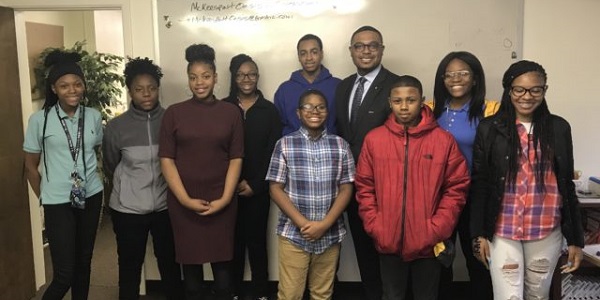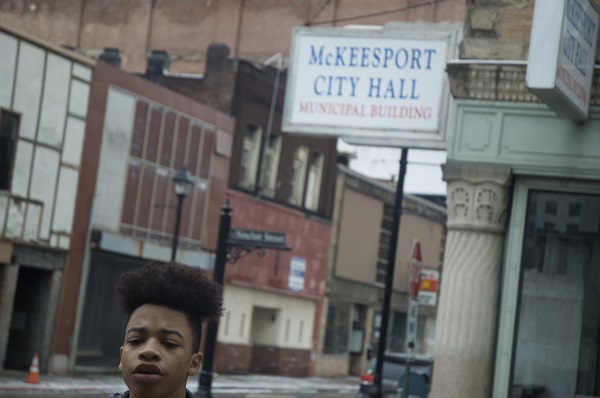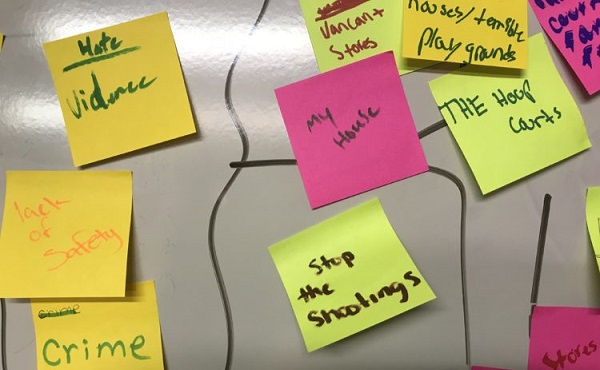
These McKeesport kids really deliver the news — through Youth CAST
Above photo: Newly elected state Rep. Austin Davis met with student journalists from the McKeesport Media Oasis. Photo by Andrew Conte.
This story was first published on NEXTPittsburgh.
By Andrew Conte
At first, no one wanted to talk.
Then, when asked what they hate about their community, the young people quickly ticked off a list of painful realities: guns, gangs, violence and the boy from school who was shot and killed in the streets.
In a place without news stories, suddenly these high school and middle school students were telling their own.
McKeesport has been a place without news — or, rather, a place without a printed newspaper — since the Daily News closed at the end of 2015.
Now, almost three years later, older residents complain of not knowing their friends have died because they never see an obituary. The fire chief talks about the time he gave out 700 coats to needy children, and how no one covered it. Many people simply shrug when asked how they find out about what’s going on.
I used to worry no one would notice the value of newspapers until they were gone. Now, it’s happening.

Academics call these places “news deserts,” but we know them for what they are: Local communities where the only place to find out what’s happening is to ask a neighbor, stop by the gas station or McDonald’s or check out what a “friend” has posted on social media.
These gaps are expanding across America and all over Western Pennsylvania. Media outlets are closing, shrinking coverage areas and laying off or buying out experienced journalists.
But I’ve never felt comfortable saying, “We used to have local news but those days are over.” Instead, we’re doing something about it.
The Center for Media Innovation has partnered with an after-school program in McKeesport called YouthCAST (Community and Schools Together) Leadership Network. Point Park University gave us a micro-grant to get started, and The Pittsburgh Foundation provided money for a pilot program this summer. My academic partner, Keino Fitzpatrick, the founder of Youth CAST, and I have been invited to present our findings at the Engagement Scholarship Consortium in Minneapolis.
The change really starts with the young people.
When we started, the student journalists remained quiet. They shied away from talking with strangers. And they seemed to feel uncomfortable about raising concerns about their community.
It wasn’t long, though, before they started to find their voices.

One of the first times we met, we used the LUMA Institute’s Rose-Thorn-Bud strategy for innovative thinking. Each student wrote on sticky notes something they love in their community, or a rose, and they talked about church, school, home and other places where they feel safe.
Their thorns included guns and gang violence, but also abandoned buildings, litter and broken playground equipment.
These young people voiced frustration about how their city has decayed, and they realized right away that without a local newspaper, those problems might go unchecked. No one would have a place to talk about them.
When it came to the buds, or the things they would like to change, one young woman said she wants to see more African American leadership. McKeesport has a diverse mix of residents but most of the local elected and appointed leaders are white. As an African American, she dreams of running for mayor someday.
About a month after this discussion, McKeesport and its Mon Valley neighbors held a special election for state representative and they selected Austin Davis, the region’s first African American state lawmaker from outside of Pittsburgh.
The Youth CAST kids suddenly had a chance to put their aspirations into action. We coached them on how to conduct interviews, and we invited Davis to meet with the young reporters. He agreed.
For more than an hour, the student journalists fired questions at the lawmaker: How would he make schools safer? What would he do about abandoned buildings? What does it feel like to be an African American community leader?
In the end, the students wrote up his answers and their impressions: “My biggest takeaway from today was that you don’t let anybody tell you what you can do,” one student wrote. “And if you put your mind to anything, you can reach. But if you don’t try to do anything, you won’t make it that far.”
The students worked with Pulitzer Prize-winning photographer Martha Rial and walked around on photo safaris to make images of the city. They wrote personal essays about the issues they face: One wrote about overcoming body shape issues, and another shared her fear of police officers after the Antwon Rose shooting. They interviewed community leaders and residents at the playgrounds.
We are publishing their stories and dozens of their photographs. We also held a community celebration of the student journalists’ work.
This project alone will not solve the problem of news deserts. But in one struggling neighborhood, these young people started the process of bringing life back to their community’s shared story.
Andrew Conte writes the On Media column for NEXTPittsburgh with support from The Heinz Endowments. You may find all of his columns here, and you may reach him at PittsburghPublicEditor@gmail.com.